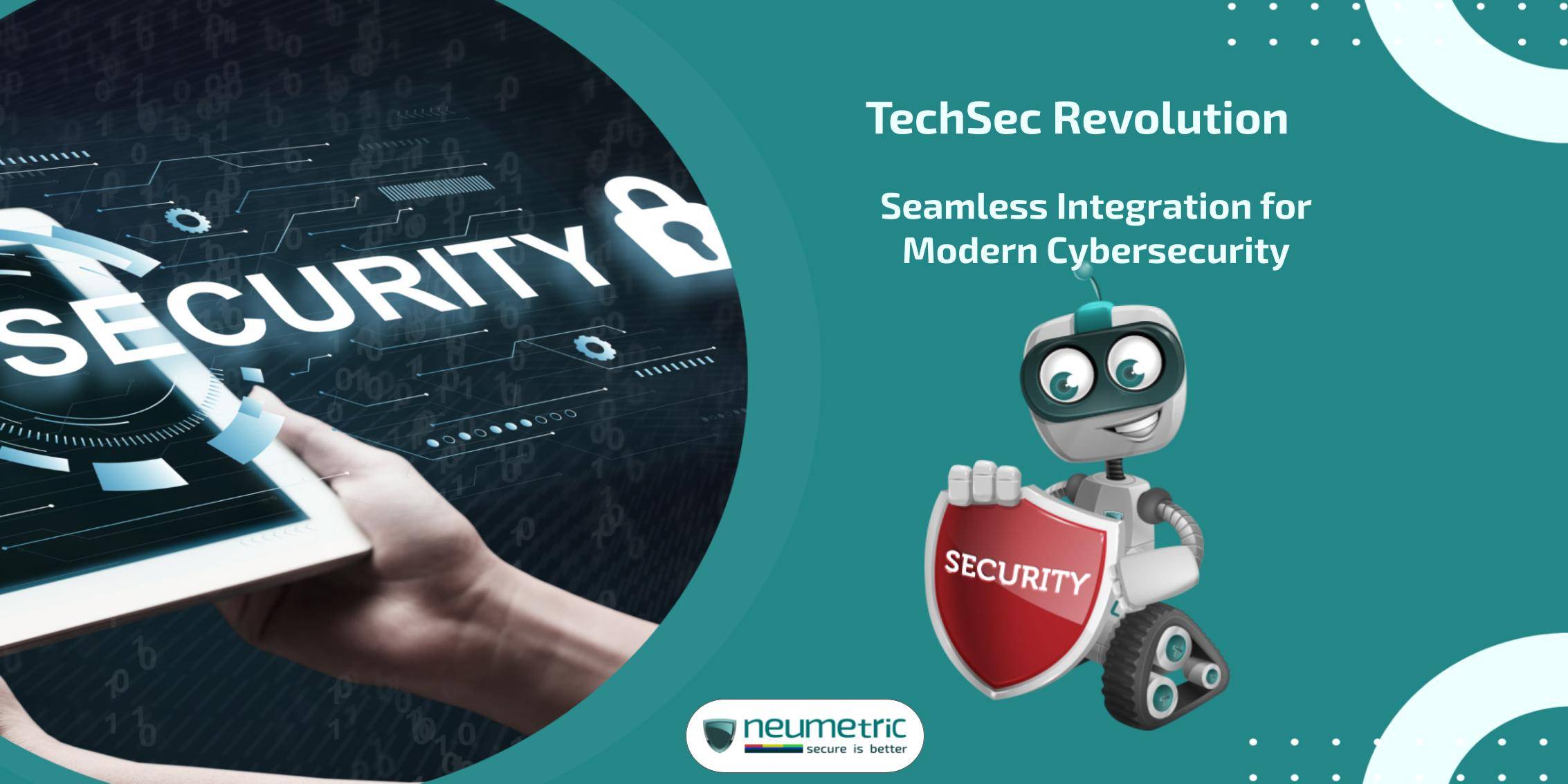Table of Contents
ToggleTechSec Revolution: Seamless Integration for Modern Cybersecurity
Introduction
Cyber threats grow more severe by the day. Headline-dominating attacks like the SolarWinds breach & the ransomware strike that nearly collapsed the Colonial Pipeline showcase a new breed of highly-motivated adversaries armed with potent new weapons to wreak havoc. Both nation-state actors & cybercriminals continuously prove ever more capable of infiltrating hard targets to pilfer valuable data or disrupt critical infrastructure. Faced with such threats, legacy models of perimeter-based network defense have badly frayed.
To keep pace, enterprises need to unify historically fragmented security capabilities into comprehensive platforms that break down barriers between overworked teams, siloed products & mountains of compartmentalized data. Integrated architectures amplify the impact of security investments by bolstering visibility, systematically eliminating exposures, accelerating response & multiplying team efficiency.
By seamlessly assimilating essential capabilities for detecting threats, orchestrating response & proactively shrinking attack surfaces, consolidated platforms provide the cohesive yet expansive foundation absolutely vital to secure the modern enterprise.
The Urgent Need to Overcome Security Fragmentation
Most sizable organizations utilize dozens of independent security products spanning endpoints, email, networks, cloud deployments & beyond. Analyst firm Enterprise Strategy Group found respondents used solutions from forty-five (45) different vendors on average. Unfortunately, such haphazard assemblages of siloed tools introduce crippling barriers:
Overwhelming Complexity for Personnel
Attempting to utilize feeds from myriad discrete systems quickly becomes an intractable mess even for experts. Monitoring a deluge of disjointed alerts while navigating dozens of management consoles consumes inordinate focus. According to one survey from Demisto, security employees spend more than twenty-five percent (25%) of time just “maintaining” fragmented toolsets. Rather than concentrating on improving defenses, highly skilled analysts waste countless hours on mundane upkeep.
Debilitating Lack of Holistic Visibility
With data siloed in disconnected systems, accurately assessing risk & detecting sophisticated threats grows extremely difficult. Key indicators get missed as stealthy actors take advantage of blindspots to penetrate deep into networks unseen. According to IBM, breaches now take over two-hundred (200) days on average to even discover due largely to limited visibility amid complex security stacks.
Painfully Delayed Response Cycles
Even if a compromise triggers alerts, responding crosses disconnects between products. Analysts must manually pivot between dozens of consoles, tying together pieces into coherent narratives. This friction drastically slows threat investigation, containment & remediation. Enterprise Strategy Group found contributors estimate four fifths of incident response time gets wasted navigating tool boundaries & disjointed workflows.
The result of such extensive fragmentation? Substantially degraded security postures despite massive investments in defenses. Systems with little interoperability fail to match the sophistication of modern attacks or the pace at which threats now move.
Making Unified Security a Reality
To meet surging threats, organizations must shift toward integrated architectures that dissolve divides between historically independent capabilities. Rather than just accumulating controls, emphasis must go to unifying visibility, analytics, workflows & data flows across critical use cases spanning threat detection, investigation, mitigation, vulnerability management & overall system hardening.
This transition centers around Security Orchestration, Automation & Response [SOAR] platforms capable of ingesting telemetry from disparate monitoring tools. SOAR assimilates alerts alongside endpoint, network, user behavior & other data into holistic analysis. Output includes Machine Learning [ML] detecting patterns indicative of compromise, automation accelerating response via predefined playbooks & orchestration stitching workflows between otherwise disconnected tools.
As a force multiplier maximizing analyst productivity, SOAR meaningfully improves:
- Rapid Threat Detection: Machine learning spots stealthy attacks missed across fragmented data pools
- Streamlined Investigations: Unified interfaces & automated playbooks replace manual task switching
- Accelerated Response: Orchestration breaks down tool barriers to enable continuous workflows
- Proactive Exposure Elimination: Central dashboards continually assess vulnerabilities in context to focus remediation
However, most SOAR platforms focus heavily on detection & response while providing little support for proactively shrinking attack surfaces via vulnerability management.
Closing the Loop on Security Weaknesses
Cyber risk stems from both external threats & ongoing vulnerabilities in an organization’s own technology stack. Unpatched systems frequently contain hundreds of publicly known flaws providing vectors for lateral movement. Misconfigurations & poor architecture decisions likewise introduce preventable risk continuously exploitable by attackers.
That’s why offensively probing environments for weaknesses constitutes a pivotal component of cyber resilience planning through disciplines such as Vulnerability Assessment & Penetration Testing [VAPT]. By providing continuous visibility into exposed assets & system weaknesses, VAPT furnishes actionable insights to preemptively eliminate entryways rather than just hoping to spot adversaries post-infiltration.
However, considerable opportunity for tighter integration remains largely untapped. All too often, vulnerability data resides disconnected in a vacuum. Scanner findings flow into tedious ticketing processes rather than directly activating automated remediation workflows. Lack of visibility into related threat telemetry & business context likewise hampers effective prioritization.
These gaps showcase precisely why thought leaders increasingly advocate assimilating scanning directly into broader SOAR ecosystems. Tighter unification provides necessary context around asset criticality & exploitability to focus limited remediation resources. Continuous data exchange also ensures tests adapt to stay relevant as environments & threats evolve.
Enhancing SOAR via Bidirectional VAPT Integration for modern cybersecurity
Whereas most SOAR platforms already ingest alerts from various security monitoring tools, assimilating vulnerability scanners closes the loop on risk visibility. Rather than periodic point-in-time checks, tests furnish continuous diagnostics to stay ahead of risk.
Moreover, bi-directional integration creates symbiotic benefits for both SOAR & VAPT:
SOAR Sharpens VAPT Efficacy
- Prioritizes Results Based on Threats & Asset Criticality
- Identifies at-risk Areas Requiring More Frequent Testing
VAPT Strengthens SOAR Protections
- Uncovers Hidden Assets to Expand Monitoring Scope
- Seeds Investigation Playbooks with Compromise IOCs
- Feeds Remediation Workflows to Systematically Reduce Exposure
In short, integrated VAPT completed the circuit for security teams – eliminating weaknesses proactively rather than only reacting once breached. Unified platforms are thus poised to meet the challenges of modern cyber risk.
Consolidating Capabilities for Comprehensive Security
Synthesizing telemetry, analytics & workflows across security use cases is indispensable given continuously evolving threats. As new attack paradigms repeatedly bypass traditional controls, holistic visibility & rapid coordinated response become mandatory.
Joint SOAR & VAPT form an integrated nerve center, breaking down historic data barriers between security monitoring, scanning, ticketing & remediation tasks. Correlated analytics guide threat hunting & vulnerability prioritization while playbooks & orchestration accelerate response via automation.
All-in-one platforms now make such unified security achievable by converging essential capabilities onto shared data models. Core benefits include:
- Reduced Complexity: Consolidate disparate tools under consistent interfaces & streamlined management.
- Improved Visibility: Centralized data lake enables holistic monitoring & control.
- Enhanced Analytics: Spot threats despite evasion by correlating insights enterprise-wide.
- Accelerated Response: Orchestrate workflows across integrated product modules with no tool switching.
- Maximized Analyst Productivity: Focus expert personnel on highest-value efforts rather than maintenance.
- Continuous Exposure Reduction: Systematically eliminate vulnerabilities through automated remediation processes.
By seamlessly covering critical use cases within unified architectures, integrated platforms resolve the crippling divides organizations long struggled with. Going forward, convergence presents the clearest path to help security match the sophistication & speed of modern attacks.
Overcoming Integration Barriers
Given the overwhelming benefits of tightly coupled security confer, why haven’t more organizations achieved meaningful consolidation & coordination of defenses until now? Two primary challenges long delayed progress:
Prohibitive Difficulties with Manual System Integration
Getting disjointed products to coordinate poses complications even for experts. Whether attempting one-off scripts or more systematic middleware, challenges multiply quickly: mismatched data formats, limited tool APIs, debilitating system complexity as integration points increase. Attempting even halfway reliable bi-directional data flows requires overcoming endless obstacles. Lacking pre-built connectors & supported integration workflows, most roll-your-own projects fail to deliver ROI.
Extreme Vendor & Product Fragmentation
Myriad niche point solutions focus almost exclusively on advancing isolated capabilities rather than collaborating across ecosystem partners. Yet no single vendor realistically out-innovates all others across every security domain. The resulting fragmentation forced organizations to choose between subpar all-in-one suites vs. the integration headaches of a best-of-breed cobbled mix.
Thankfully, the solution to both issues has already begun taking shape. As cyber risks compounded, innovative vendors responded by converging essential capabilities onto unified platforms centered around hypertight feature integration. By bringing historically independent tools together within shared backends, analytics engines & automated workflows, these emerging all-in-one offerings overcome the burdens organizations long shouldered.
Rather than just another product, modern integrated platforms provide the essential foundation needed to build genuinely resilient cybersecurity postures capable of withstanding everything sophisticated threat actors now unleash.
Conclusion
As cyber incidents accelerate exponentially in frequency & impact yearly, traditional controls centered on defending perimeters fail badly. Extreme fragmentation across security tools purchased leaves dangerous visibility gaps unable to match sophisticated adversaries.
The only answer is assimilating essential capabilities onto integrated platforms built to enable unified data collection, correlated analytics, automated response via playbooks & orchestration & continuous vulnerability elimination.
By delivering converged solutions that meet all modern security use cases holistically, next generation vendors are finally helping enterprises overcome debilitating complexity & keep pace with threats. For security leaders seeking continuously resilient defenses, pivoting to truly unified platforms offers the only viable path forward.
Key Takeaways
- Legacy security tools functioning in silos severely limit defense capabilities against sophisticated modern threats.
- Integrating insights & workflows across security solutions via unified SOAR platforms maximizes resilience.
- Incorporating bi-directional vulnerability assessment can systematically eliminate weaknesses before adversaries exploit them.
- Emerging all-in-one vendors allow organizations to realize integrated security architectures with minimized time & effort.
- Consolidated platforms resolve crippling complexity & visibility issues stemming from fragmented security products.
- Joint SOAR & VAPT form an integrated nerve center for continuous exposure monitoring, automated threat response & hardened defenses.
Frequently Asked Questions [FAQ]
What are some key benefits of security integration?
Core benefits include increased visibility across tools, improved threat analytics via correlated data, automated response workflows, greater overall efficiency & continuously minimized attack surfaces by eliminating vulnerabilities systematically.
What does bi-directional integration between SOAR & VAPT entail?
SOAR enhances vulnerability insights with added context on exploitability & business risk to focus remediation using threat intel & asset criticality data. Meanwhile, VAPT continuously feeds exposed assets & weaknesses to better guide SOAR monitoring scopes & response playbooks.
What challenges has security integration faced in the past?
Manual integration often proves excessively complicated given mismatched APIs & data formats. Meanwhile, the previously highly fragmented security vendor landscape lacked converged offerings natively enabling unified capabilities.
How are emerging platforms overcoming historical integration issues?
Consolidated cybersecurity platforms assimilate SOAR, VAPT & other essential capabilities together onto common backends, eliminating painful system integration requirements. Unified data pipelines, analytics & automated workflows overcome past data & workflow barriers.
Why is integrated security so crucial for modern enterprises?
Highly motivated & capable attackers now move at machine speeds. Only platforms enabling unified visibility, orchestration & automation across historically siloed monitoring & response tools allow defenders to keep pace. Integrated convergence exponentially amplifies security postures.





